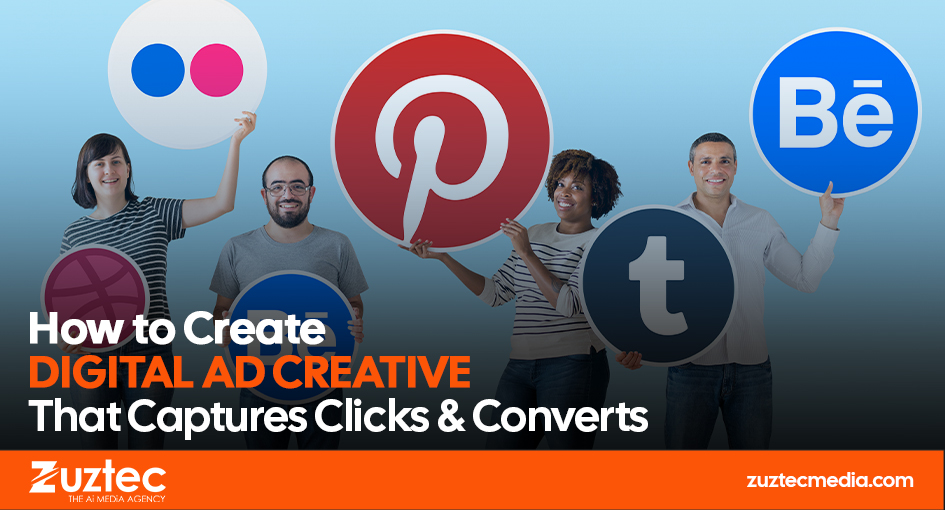
How to Create Digital Ad Creative That Captures Clicks & Converts
In today’s competitive online marketplace, having a solid advertising strategy is crucial, but even the best strategy will fall flat without compelling digital creatives. The first thing your audience sees is your creative. It’s the visual and messaging component that either grabs attention or gets ignored in a sea of content. Whether it’s a static image, a video, an animated banner, or a carousel ad, digital advertisement creative plays a central role in driving engagement and conversions.
Digital ad creative combines design, copywriting, and user psychology to convey a message quickly and effectively. To stand out, your creative must instantly resonate with your audience, communicate value, and prompt them to take action.
Great advertisement creatives aren’t just about beautiful visuals or clever taglines. It’s about understanding your audience, aligning your message with their needs, and designing for the platforms they use. Whether you’re running ads on Google, Facebook, Instagram, TikTok, or YouTube, adapting your creative to the platform’s format and audience expectations can drastically improve results.
This article breaks down the key elements and best practices for creating high-performing digital creatives. From knowing your audience and choosing the right format to crafting compelling visuals and testing variations, we’ll explore what goes into ads that convert. Whether you’re a business owner, marketer, or designer, these insights will help you build creatives that drive real impact and ROI.
What Is Digital Ad Creative?
These digital creatives refer to the visual and textual content used in online advertisements. It includes elements such as
- Imagery (photos, graphics, videos)
- Text (headlines, CTAs, descriptions)
- Design layout
- Brand elements (logos, colors, fonts)
This creative is the “face” of your ad campaign—what users see, engage with, and react to.
Why Digital Advertising Creative Matters
- Captures attention in crowded feeds or webpages
- Communicates value quickly
- Drives click-throughs and conversions
- Supports brand recognition
Even with perfect targeting, poor creative can ruin campaign performance. On the flip side, powerful visuals and messaging can boost engagement, lower ad costs, and increase return on ad spend (ROAS).
1. Understand Your Audience
Before designing, define your audience:
- Who are they (age, interests, job roles)?
- What are their pain points?
- What platforms do they use?
- What content do they engage with?
Audience insights should inform your visuals, tone of voice, and messaging.
Tip: Use audience personas and platform analytics to guide design choices.
2. Choose the Right Ad Format
Different formats work best on different platforms:
- Static image ads: Simple and clear, great for product promotion.
- Carousel ads: Ideal for showcasing multiple features or products.
- Video ads: Highly engaging; perfect for storytelling and demos.
- Animated banners: eye-catching in display networks.
Choose a format that complements your message and platform. For example, Instagram favors visuals, while LinkedIn supports more detailed, professional content.
3. Make Your Message Clear
You only have seconds to communicate your value proposition. Keep it concise:
- Use bold, punchy headlines
- Focus on one core benefit.
- Add a strong CTA (e.g., “Shop Now,” “Start Free Trial”)
4. Use Eye-Catching Visuals For Best Digital Ad Creative
Design visuals that pop.
- Use high-resolution images
- Add contrasting colors to make CTAs stand out
- Incorporate movement where appropriate (GIFs, short animations)
Visuals should align with your brand and feel authentic to your audience.
5. Maintain Consistent Branding
Consistency builds trust and brand recall. Ensure that all creatives
- Use your brand colors and fonts
- Feature your logo (in a subtle way)
- Reflect your brand’s tone (fun, professional, bold, etc.)
This helps build recognition across multiple touchpoints.
6. Optimize for Mobile
Most users will view your ads on mobile. Ensure that:
- Text is legible on small screens
- Images load quickly
- CTAs are easy to tap
Use vertical or square formats for platforms like Instagram Stories or TikTok.
7. Use Emotional Triggers
- Joy: “Feel great in your skin.”
- Fear of missing out (FOMO)
- Relief: “Finally, a solution to your biggest problem.”
Match emotional tone with imagery for more impact.
8. Test Different Variations
No matter how confident you are in your design, always test:
- Different headlines
- Alternate images or colors
- Varying CTAs
Use A/B testing tools in platforms like Facebook Ads Manager or Google Ads to compare performance. Scale what works.
9. Analyze and Refine Regularly
Don’t set it and forget it. Use analytics tools to:
- Track CTR, conversions, and engagement
- Identify underperforming creatives
- Understand what resonates most with your audience
Use insights to refine future campaigns.
Significantly, digital ad creative is where strategy meets execution. It’s what brings your campaigns to life and makes people stop, engage, and act. The best creative is rooted in audience insight, aligned with platform best practices, and constantly evolving through testing and iteration.
If you want better results from your advertising budget, start with better creative. Clear messaging, strong visuals, and emotional resonance are the keys to unlocking higher engagement and conversion rates.
Whether you’re designing for search, social, or display, apply these principles to make your digital ads work harder—and smarter—for your brand.

